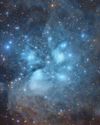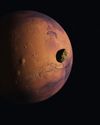Failed Stars & Super-Jupiters
Issue 113
|All About Space
The strange celestial objects that don’t make the cut as either planets or stars
-

The brown dwarf is seen as a stellar failure, a dropout from the school of star formation. These gigantic objects, with their puffy, gaseous outer layers, are the universe’s students that didn’t quite make the grade. In brown dwarfs, nuclear fusion – the process that gives stars their power – has given up the ghost, leaving them relatively cold, with some no hotter than the human body. Neither planet nor star, brown dwarfs fall into the grey area between the most massive gas giant planets like Jupiter – hence why they’re known as ‘super-Jupiters’, because of their massive, gaseous nature – and the smallest stars. Their existence blurs the lines between what is a planet and what is a star, forcing us to question the differences between how planets and stars form.
Stars form when clouds of molecular gas collapse under gravity and condense until the pressure and temperature at the center of the cloud is so great that nuclear fusion reactions – which turn nuclei of the element hydrogen into heavier helium nuclei – ignite. This kind of top-down formation is one of the key differences between how stars and planets form. Meanwhile, the worlds of our Solar System and many others that astronomers have been studying over the past 25 years form through a bottom-up process, where a core gradually builds up, becoming bigger and bigger. For the most massive planets, the core has enough gravity to begin stealing gas from the proto-stellar nebula around it, and this is where gas giants such as Jupiter and Saturn got their hefty atmospheres.
هذه القصة من طبعة Issue 113 من All About Space.
اشترك في Magzter GOLD للوصول إلى آلاف القصص المتميزة المنسقة، وأكثر من 9000 مجلة وصحيفة.
هل أنت مشترك بالفعل؟ تسجيل الدخول
المزيد من القصص من All About Space

All About Space UK
MYSTERIES OF THE UNI WHERE ARE ALL THE SPIRAL GALAXIES?
There are far fewer spiral galaxies than elliptical ones in the Supergalactic Plane, and scientists are keen to discover why
7 mins
Issue 161

All About Space UK
ZOMBIE STARS
+10 OTHER TERRIFYING SPACE OBJECTS
8 mins
Issue 161

All About Space UK
HOW TO BEAT LIGHT POLLUTION
Thought it was impossible to observe the wonders of the night sky from towns and cities? Think again. Follow our tips and tricks on successfully observing through sky glow
2 mins
Issue 161

All About Space UK
15 STUNNING STAR CLUSTERS
These beautiful stellar groupings are spattered across the cosmos
8 mins
Issue 161

All About Space UK
Eileen Collins "It was a difficult mission...we were the first to see Mir"
Having served as both the first female pilot and first female commander of NASA's Space Shuttle, Collins boosted the involvement of women in space exploration to a whole new level
9 mins
Issue 161

All About Space UK
MARS LEAKS FASTER WHEN IT'S CLOSER TO THE SUN
The Red Planet has lost enough water to space to form a global ocean hundreds of kilometres deep
2 mins
Issue 161

All About Space UK
FUTURE TECH KANKOH-MARU
This ambitious reusable spacecraft will be capable of taking 50 people to and from orbit
2 mins
Issue 161

All About Space UK
THE FINAL FRONTIER
Beyond the reach of the Sun is a fascinating region of the cosmos that were only just beginning to explore
8 mins
Issue 161

All About Space UK
A long-lost moon could explain Mars' weird shape and extreme terrain
A long-lost moon could explain why Mars is so different from the other rocky planets in the Solar System. Today Mars has two tiny moons.
2 mins
Issue 161

All About Space UK
A sprinkling of cosmic dust may have helped kick-start life on Earth
Cosmic dust may have helped kick-start life on Earth. New findings challenge a widely held assumption that this wasn't a plausible explanation.
3 mins
Issue 161
Translate
Change font size

